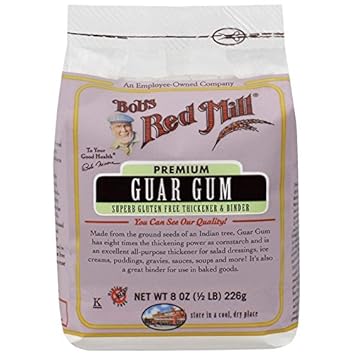As you have probably noticed, xanthan gum is my thickener of choice. When you are switching to gluten-free flour, the flour texture and properties are much different from wheat flour. One thing that is very different is it's sticking/thickening abilities. To compensate for gluten-free flours lack of those qualities you can add one of the following thickeners to your recipes.
General Tips for Using Xanthan Gum and Guar Gum in Gluten-Free Cooking from About.com
- Bread and pizza dough recipes: Add 1 teaspoon xanthan gum or guar gum per cup of gluten-free flour used in bread and pizza dough recipes
- Cake, muffin and quick bread recipes: Add 1/2 teaspoon xanthan gum or guar gum per one cup of gluten-free flour used
- Cookie and bar recipes: Add 1/2 teaspoon (or less) xanthan gum or guar gum per one cup gluten-free flour used
Note- For best results follow recipe recommendations when using xanthan gum or guar gum.
What is Guar Gum?
 "Guar Gum is a white flour-like substance made from an East Indian seed. Use small amounts as a thickener, binder, and volume enhancer. Instructions for use on package."
"Guar Gum is a white flour-like substance made from an East Indian seed. Use small amounts as a thickener, binder, and volume enhancer. Instructions for use on package."- What is Xanthan Gum?
Xanthan gum has a number of powerful properties. First, it works as an emulsifier, encouraging liquids that normally don't like one another to mix together. Second, it works as thickener, increasing the viscosity of liquids and batters. Third, it can create a creamy texture.
In the world of gluten-free baking, xanthan gum plays the crucial role of imitating gluten. In baking, gluten is what makes dough "doughy." It gives the dough elasticity, as well as viscosity. Those properties help to hold a cookie together while it bakes on a sheet in the oven, and they enable cakes and breads to hold onto the gas bubbles that form inside them - this allows them to rise and take shape. Xanthan gum helps replicate these properties in recipes that do not contain gluten."Xanthan Gum is a plant-based thickening and stabilizing agent. It is named for the bacteria, Xanthomonas campestris, which plays a crucial role in this description. Technically speaking, xanthan gum is a polysaccharide, which is just a fancy way to say "a string of multiple sugars." To create xanthan gum, the Xanthomonas campestris bacterium is allowed to ferment on a sugar. The result is a gel that is then dried and milled to create the powder substance. - I got these definitions from Bob's Red Mill's site. I love me some Bob's Red Mill!
No comments:
Post a Comment